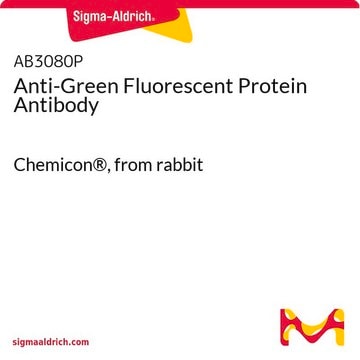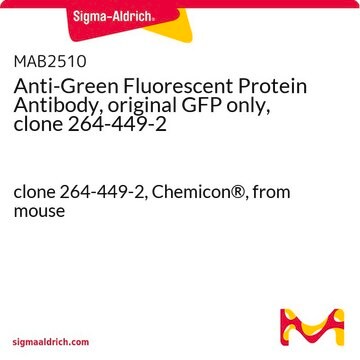AB10145
Anti-GFP Antibody
Chemicon®, from rabbit
Zaloguj sięWyświetlanie cen organizacyjnych i kontraktowych
About This Item
Kod UNSPSC:
12352203
eCl@ss:
32160702
NACRES:
NA.41
Polecane produkty
pochodzenie biologiczne
rabbit
Poziom jakości
forma przeciwciała
affinity purified immunoglobulin
rodzaj przeciwciała
primary antibodies
klon
polyclonal
oczyszczone przez
affinity chromatography
reaktywność gatunkowa (przewidywana na podstawie homologii)
all
producent / nazwa handlowa
Chemicon®
metody
western blot: suitable
numer dostępu GenBank
numer dostępu UniProt
Warunki transportu
wet ice
docelowa modyfikacja potranslacyjna
unmodified
Specyficzność
The antibody reacts with the 28 kDa GFP protein.
Immunogen
Synthetic peptide corresponding to the full length of GFP protein.
Zastosowanie
Research Category
Epitope Tags & General Use
Epitope Tags & General Use
Research Sub Category
Epitope Tags
Epitope Tags
This Anti-GFP Antibody is validated for use in WB for the detection of GFP.
Western blot: 0.1 μg/mL on GFP recombinant protein.
Optimal working dilutions must be determined by the end user.
Optimal working dilutions must be determined by the end user.
Opis wartości docelowych
28 kDa
Postać fizyczna
Antigen Affinity Purified
Purified rabbit immunoglobulin in buffer containing PBS containing 0.05% sodium azide.
Przechowywanie i stabilność
Maintain at 2-8°C in undiluted aliquots for up to 1 year after date of receipt. Avoid repeated freeze/thaw cycles, which may damage IgG and affect product performance.
Informacje prawne
CHEMICON is a registered trademark of Merck KGaA, Darmstadt, Germany
GenBank is a registered trademark of United States Department of Health and Human Services
Oświadczenie o zrzeczeniu się odpowiedzialności
Unless otherwise stated in our catalog or other company documentation accompanying the product(s), our products are intended for research use only and are not to be used for any other purpose, which includes but is not limited to, unauthorized commercial uses, in vitro diagnostic uses, ex vivo or in vivo therapeutic uses or any type of consumption or application to humans or animals.
Not finding the right product?
Try our Narzędzie selektora produktów.
Kod klasy składowania
12 - Non Combustible Liquids
Klasa zagrożenia wodnego (WGK)
WGK 1
Temperatura zapłonu (°F)
Not applicable
Temperatura zapłonu (°C)
Not applicable
Certyfikaty analizy (CoA)
Poszukaj Certyfikaty analizy (CoA), wpisując numer partii/serii produktów. Numery serii i partii można znaleźć na etykiecie produktu po słowach „seria” lub „partia”.
Masz już ten produkt?
Dokumenty związane z niedawno zakupionymi produktami zostały zamieszczone w Bibliotece dokumentów.
Klienci oglądali również te produkty
Feijia Xie et al.
Investigative ophthalmology & visual science, 63(6), 28-28 (2022-06-28)
Heat shock protein B8 (HspB8) can be upregulated rapidly in many pathologic processes, but its role in traumatic optic neuropathy remains unclear. In this study, we investigated the involvement of autophagy in the effects of HspB8 by using the optic
Tamás Wilheim et al.
Brain structure & function, 226(7), 2387-2399 (2021-07-16)
The endocannabinoids have been shown to target the afferents of hypothalamic neurons via cannabinoid 1 receptor (CB1) and thereby to influence their excitability at various physiological and/or pathological processes. Kisspeptin (KP) neurons form afferents of multiple neuroendocrine cells and influence
Maniraj Bhagawati et al.
Molecular biology of the cell, 32(20), br1-br1 (2021-08-05)
The outer membrane translocase (TOM) is the import channel for nuclear-encoded mitochondrial proteins. The general import pore contains Tom40, Tom22, Tom5, Tom6, and Tom7. Precursor proteins are bound by the (peripheral) receptor proteins Tom20, Tom22, and Tom70 before being imported
Hongliang Zhang et al.
Nature communications, 13(1), 4009-4009 (2022-07-12)
Diphthamide, a post-translationally modified histidine residue of eukaryotic TRANSLATION ELONGATION FACTOR2 (eEF2), is the human host cell-sensitizing target of diphtheria toxin. Diphthamide biosynthesis depends on the 4Fe-4S-cluster protein Dph1 catalyzing the first committed step, as well as Dph2 to Dph7
Pablo Garcia-Miranda et al.
Journal of virology, 90(15), 6906-6917 (2016-05-20)
Human immunodeficiency virus (HIV) replication is strongly dependent upon a programmed ribosomal frameshift. Here we investigate the relationships between the thermodynamic stability of the HIV type 1 (HIV-1) RNA frameshift site stem-loop, frameshift efficiency, and infectivity, using pseudotyped HIV-1 and
Nasz zespół naukowców ma doświadczenie we wszystkich obszarach badań, w tym w naukach przyrodniczych, materiałoznawstwie, syntezie chemicznej, chromatografii, analityce i wielu innych dziedzinach.
Skontaktuj się z zespołem ds. pomocy technicznej











